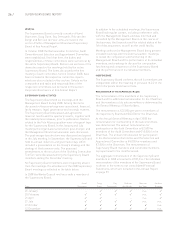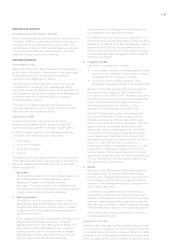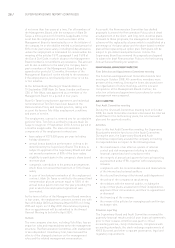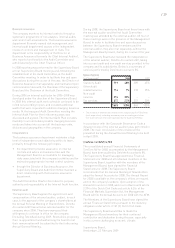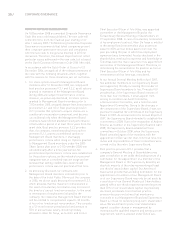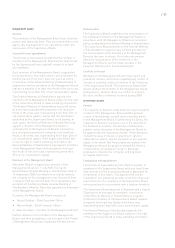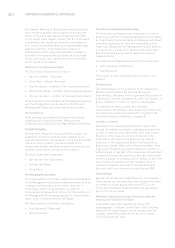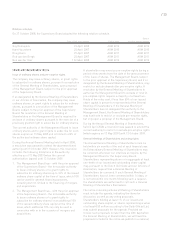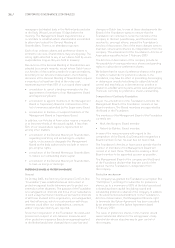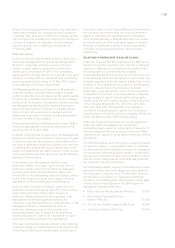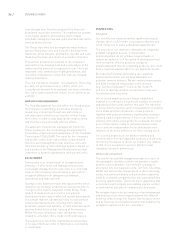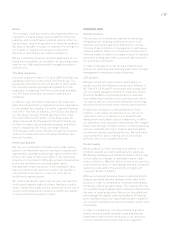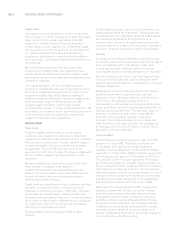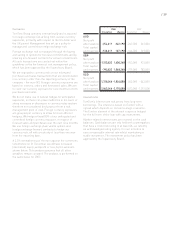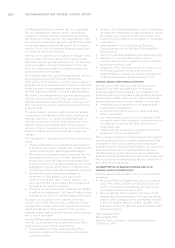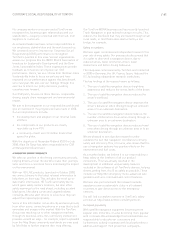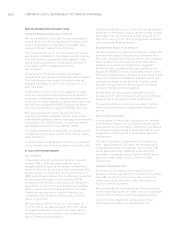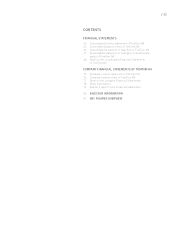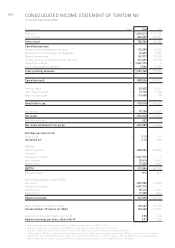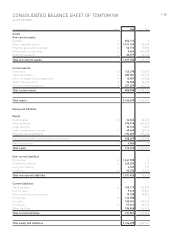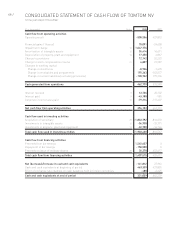TomTom 2008 Annual Report Download - page 38
Download and view the complete annual report
Please find page 38 of the 2008 TomTom annual report below. You can navigate through the pages in the report by either clicking on the pages listed below, or by using the keyword search tool below to find specific information within the annual report.36 / BUSINESS RISKS
Over the past year TomTom acquired Tele Atlas and
broadened its product portfolio. The markets we operate
in are highly dynamic and evolving, which makes
effectively managing risks and opportunities essential for
success and continuity.
Our Group objectives can be negatively impacted by a
variety of business risks and economic developments.
Revenues, gross margins, profitability, liquidity and cash
flows may fluctuate as a result of a number of factors.
This section presents an overview of the company’s
approach to risk management and a description of the
nature and the extent of its exposure to risk. The most
important risks identified are highlighted below, and
should be considered in connection with any forward-
looking statements.
This risk overview is, however, not exhaustive. There may
be risks, not yet known to us or others, which are
currently not deemed to be material, but that could later
turn out to have a significant impact on our business as
a whole.
APPROACH TO RISK MANAGEMENT
The Risk Management function within the Group assists
the business in identifying, prioritising, assigning,
resourcing, monitoring through key performance
indicators and controlling our mission critical longer
term risks, in order to take appropriate steps to avoid
and minimise any potentially adverse effects.
The approach towards risk management within the
Group is based on the methodology developed by the
Committee of Sponsoring Organisations of the Treadway
Commission (COSO ERM). The input for the company’s
risk profile comes from risk surveys conducted with
directors and management of all business units and
from benchmarking risks identified by peers. Based on
a discussion in the Management Board meeting, final
consensus is agreed regarding the top business risks.
RISK CATEGORIES
Taking risks is an inherent part of entrepreneurial
behaviour. A structured risk management process
encourages management to take risks in a controlled
manner. The company has processes in place which
recognise different risk categories at strategic,
operational and financial level.
Strategic risks address threats and opportunities which
influence our strategic ambitions as well as the effects
changes in the market may have on the Group. Risks
related to areas such as economic and political
developments are likely to affect all market participants
in a similar manner. Operational risks include adverse
unexpected developments resulting from internal
processes, people and systems, or from external events
that are linked to the actual running of the business.
Within the area of financial risks, we identify risks
related to, amongst others, trade credit and treasury.
The sequence in which the risks below are presented
in no way reflects an order of importance, vulnerability
or materiality.
STRATEGIC RISKS
Innovation
Our markets are characterised by rapid technological
change, which could render our products obsolete and
could compel us to make substantial expenditures.
The majority of our revenue is derived from integrated
portable navigation devices. If new product
implementations do not achieve required levels of
market acceptance, or if the speed of development and
time-to-market of these products compares
unfavourably with directly competing products, this could
have a material adverse effect on our business results.
By acquiring Tele Atlas and setting up a separate
Automotive business unit we have expanded our
potential revenue streams. We are seeking new markets
and have introduced new products and services
(e.g. TomTom IQ Routes™, TomTom HD Traffic™),
and aim to diversify product concentration risks over
the medium and long-term.
Our in-house engineering and design capabilities
enabled us to introduce a significant number of new and
upgraded products and services this year. The transition
to new products requires careful management of existing
stock levels and the introduction of new products,
together with seasonal demand, significantly increases
working capital requirements. If there is an excess of
existing stock when a new product is released, the retail
price of that stock is likely to decrease and we could
incur costs for compensation to our distributors and
retailers on the price difference for their existing stock.
Our success depends on our ability to develop and
commercialise new and upgraded products and services,
the timing of releases of these, our product mix relative
to that of our competitors, and our ability to meet
changing consumer preferences.
Market and competition
The market for satellite navigation products in each of
the geographic markets in which we operate is highly
dynamic and competitive. Currently the company is
structured into four business units; TomTom, Tele Atlas,
WORK and Automotive. Convergence in the technology,
media, telecommunications and automotive industries
leads to increased competition but also associated new
business opportunities. There can be no guarantee that
our products will compete successfully against current
or new market entrants or competing technologies.
We mitigate these risks by investing in the development
and sharing of our technologies between the different
business units through the Shared Technologies centre
and by focusing on innovative benefits that enhance the
navigation experience for our customers.


